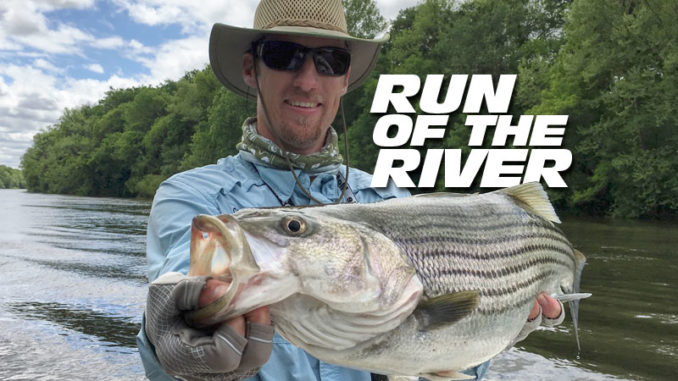
Striped bass begin to spawn in Weldon during Arpil
Mitchell Blake has been roaming North Carolina’s Roanoke River for 33 of his 43 years.
He begins fishing for striped bass in the Albemarle Sound in November and December before he follows their spawning run upstream to Plymouth, N.C., then all the way to Weldon. This is where they actually begin to spawn in April.
“I usually start fishing out of Weldon around April 18 or so,” Blake said. “By that time, there have been eight or nine big pushes of fish up to that area of the river. It creates epic striper fishing when all of those schools come together. The ideal water temperature leading to the best fishing is around 68 degrees.”
Blake fishes from two different boats, both carrying outboards with aluminum propellors because of the river’s shallow, rocky hazards.
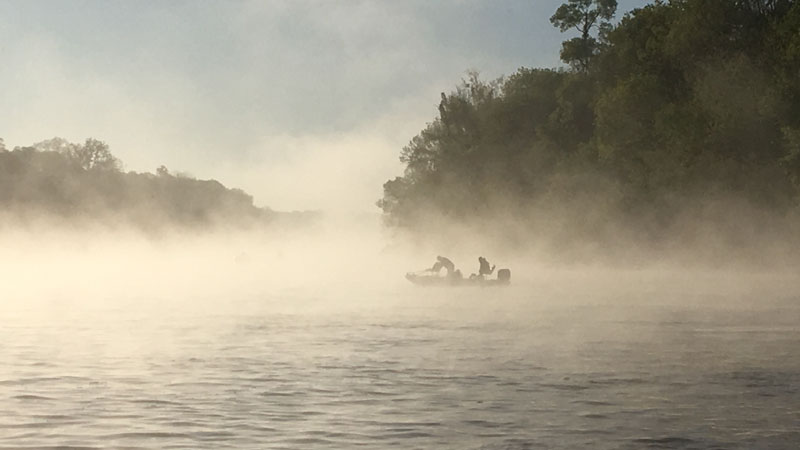
“You just have to learn where the rocks and pools are located,” he said. “I run inexpensive, aluminum propellers. Eventually, you are going to have to pay to play when you bang up a prop or skeg on a rock.
“I really enjoy doing my own thing, so I head upstream when I can. But at times, you just can’t when the water is too low. If you second-guess anything you want to do in the river, don’t do it. There is no forgiveness. And if something goes haywire upstream of the ramp, you are going to be on your own.”
A steady flow of water helps the fishing, not matter the water level
Allowable water-flow agreements for the river have changed over the past few years, so greater amounts of water are released during the striper run through hydroelectric plants that impound lakes upstream.
Water flow affects the fishing more than anything else during the “keeper” season in March and April, when most anglers head to the area. The best fishing occurs when the flow is steady, and it doesn’t seem to matter much if the water level is high or low. A sudden release from the dam is such a temperature shock to the stripers that it disrupts the fishing until the flow stabilizes. High flows can also move the fish downstream and may even cause flooding that gives the fish a lot more places to hide, making fishing more difficult.
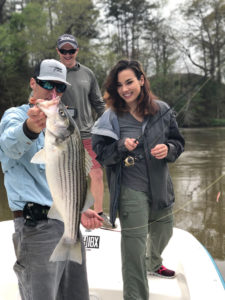
“In a typical day, I launch the boat and drift with live bait,” Blake said. “The boat floats at the speed of the current, and I use a slip-sinker Carolina rig with an ounce or less of weight and a Little Demon No. 2 wire circle hook. I keep the weight as light as possible to keep the bait down in the current while allowing it to swim freely. I use threadfin shad for bait. If the water flow is low enough to use a cast net, I catch my own. If not, I buy live shad from a bait dealer.”
Striped bass are strong fighters
Blake holds onto his rod until a fish strikes, then gives the line a steady pull to let the hook set itself. Most rockfish weigh between one and 10 pounds, with an occasional 15-pounder or much larger fish showing up. A really big one heading for log jams or rocks is difficult to control.
“When I’m drifting, I watch the depth finder for pockets of fish,” he said. “If we go through a zone with a good pocket of fish, I throw artificial lures. Going back upstream, I switch down the Power Pole, tie off to a limb or drop a mushroom anchor. You should never use an anchor that will hang in rocks.”
Blake’s favorite lure is his own custom-tied version of the popular Hairy Worm, a bucktail jig with a plastic worm trailer. In place of the plastic worm, he ties long feathers to the jighead to give the lure a 6-inch profile. He uses a ½-ounce or smaller, round leadhead jig and adds large natural eyes. His favorite color is sexy shad, which is tied with natural bucktail with a blue back, chartreuse sides and white belly with long chartreuse feathers trailing behind. Another of his favorite hand-tied jig colors is electric chicken, which is pink on top and chartreuse below.
Paddletail swimbaits are good too
“I also like using a swimbait with a big paddletail,” he said. “My largest fish have hit a Yee Ha swimbait. We have hooked fish that got into log jams that we could not stop, and they broke off.”
The reason for making the pilgrimage to the Roanoke River in March and April is the sheer number of striped bass. While the fishing can be fantastic either side of the open, keeper season, many anglers what to take home a couple of fish for eating.
“In a 3/4-day trip, two anglers can easily catch 50 to 100 stripers,” he said. “Most everybody who wants to will take home their two keepers. It can get pretty crowded when the season is open, but everybody is very respectful of other anglers because there are plenty of open pools and lots of fish to catch.”
DESTINATION INFORMATION
HOW TO GET THERE — Weldon, N.C., which bills itself as the “Rockfish Capital” of the world, is the primary jumping off point for striped bass, aka rockfish, in the Roanoke River. Weldon is just a few miles south of the North Carolina-Virginia border. The public boat ramp in Weldon is just east of I-95 at the US 158 exit., just downstream from the US 301 bridge across the river.
WHEN TO GO — The keeper season for stripers and hybrids is March 1-April 30 unless extended or closed by proclamation. The creel limit is two fish per day, with a minimum size of 18 inches and no fish between 22 and 27 inches.
BEST TECHNIQUES — Hairy Worms, bucktail jigs and live shad fished on Carolina rigs are primary weapons for striped bass in the river. A medium-action spinning rod and 3000 class reel spooled with 20-pound braid is standard tackle, with a 15-pound monofilament leader for live-bait rigs and a 20-pound mono leader for lures. Best lure colors are sexy shad, electric chicken and tutti frutti. Single, barbless hooks are required April 1-June 30 upstream of the U.S. 258 bridge. Fly-fishing with an 8-weight outfit, sinking line with a 4-foot leader of 15-pound monofilament at Clousers is an option.
FISHING INFO/GUIDES — Capt. Mitchell Blake, Fish IBX Guide Service, 252-495-1803. Fishibx.com; Capt. George Beckwith, Down East Guide Service, 252-671-3474, www.pamlicoguide.com. See also Guides & Charters in Classifieds.
ACCOMMODATIONS — Red Roof Inn, Roanoke Rapids, 252- 541-4260; SureStay Plus, Roanoke Rapids, 252-536-2300; Halifax County Convention and Visitors Bureau, 800-522-4282, www.visithalifax.com.
MAPS — DeLorme North Carolina Atlas and Gazetteer, 800-452-5931, www.delorme.com.
Catching stripers on the fly
Fly-fishing is popular during the Roanoke River striped bass run because the numbers of fish make it easy to be successful.
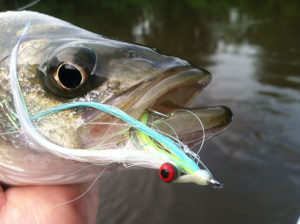
Guide Mitchell Blake of Fish IBX Charters rigs 8-weight, medium-action Temple Fork Outfitters fly rods with TFO reels spooled with Royal Wulf Striper Series lines weighing 200, 300 and 400 grains. A striper line is a clear, sinking line that stays supple in cold water. Which line he uses depends upon the current flow and the depth he sees fish on his depth finder. The leader is 4 feet of 15-pound test monofilament.
Blake casts a medium- or heavy-eye Clouser minnow in sexy shad or tutti frutti color patterns or a Flat Wing in blue/charteuse/white. The heavy fly line is coiled on the deck and shot forward, rather than lengthened gradually with several false casts.
“I locate the fish and anchor beside them,” Blake said. “Then I cast at a 15-degree angle upstream and let the line sink as it drifts, mending the line to keep it tight. When it is nearly perpendicular to the boat, I make short, fast strips. If a fish doesn’t hit the fly as it sinks, it should strike during on the strips. If you let it drift too far downstream, the line lifts the fly out of the strike zone.”

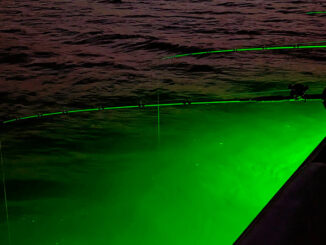


Be the first to comment